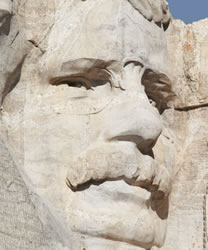 While catching up on the weekend’s reading I came across an article Debate rages in coin world: Theodore Roosevelt or George Washington on new quarter? The article is about how the Citizens Coinage Advisory Committee debated whether to recommend that Teddy Roosevelt be placed on the obverse of the new America the Beautiful Quarters.
While catching up on the weekend’s reading I came across an article Debate rages in coin world: Theodore Roosevelt or George Washington on new quarter? The article is about how the Citizens Coinage Advisory Committee debated whether to recommend that Teddy Roosevelt be placed on the obverse of the new America the Beautiful Quarters.
Introduced in 1932, the Washington Quarter was intended to be issued as a one-time circulating commemorative to honor the 200th anniversary of George Washington’s birth. The quarter was born of controversy when Secretary of the Treasury Andrew Mellon chose John Flanagan’s depictions over what had been determined to be a more artistic version by Laura Gardin Fraser. Although Mellon was a collector of great fine art that was later donated to the National Gallery of Art, many knew he was a sexist and refused to consider that a woman’s work was better than a man’s.
As the Great Depression deepened, no quarters were struck in 1933. Toward the end of the year, US Mint director Nellie Tayloe Ross was asked by the Federal Reserve to produce more quarters for circulation. Rather than use a new design, Ross ask the Treasury Secretary William Woodin for permission to continue to use Fraser’s design. Since Ross and Woodin did not want to undergo a new design competition, the Fraser designed continued until it was "updated" in 1999 for the 50 State Quarters Program.
Numismatist see Teddy Roosevelt as the father of the coinage renaissance when he tried to conspire with Augustus Saint-Gaudens to bring classic design to American coinage. Roosevelt call this his Pet Crime. Roosevelt was instrumental in the Mint using Saint-Gauden’s designs for the $10 gold eagle and his famous design on the $20 gold double eagle coin that continues to be celebrated today. Add the wonderful work by Bela Lyon Pratt on the gold quarter and half eagle coins along with Victor David Brenner’s Lincoln cent and the stage was set for a period of timeless classics.
Under his presidency, Roosevelt made conservation a national priority. He placed more land into the public trust than any other president and created the US Forest Serive to care for that land. Roosevelt elevated the importance of the National Park Service to be more than a caretaker of public land but make it accessible to everyone while protecting its beauty. His service to conservation has not been matched by any president since.
With his work on coinage and the lands that will be featured on the new series, it would be a natural recommendation to have Roosevelt adorn the obverse of these quarter. However, the article reports that the CCAC backed down because of the alleged lack of support by congress.
The CCAC is supposed to be an independent organization that is supposed to recommend what is best for the design of American coinage. It is supposed to be a non-partisan and non-political organization that apparently succumbed to the politics of the day. Rather than doing what is right, the CCAC wilted at the chance to refresh the sameness of the one coin’s design in the same way that Roosevelt bristled at the designs of Charles Barber in the early 20th century.
I am sure that members of the CCAC will ask that if there is no support for the design then why propose it? Because at some point, it is more important to do the right thing than taking the politically expedient path. It would put congress on record as being against a populist idea, albeit a small population of populists. It would show that the CCAC was an organization that understand the issues of coin design and not a rubber stamp body of sometimes bland coin designs.
The CCAC must re-evaluate their role as and advisory committee and advise. If this is not possible, then the CCAC only duplicates the role of the Commission of Fine Arts and should be disbanded.
Scott Barman is a collector and author of the Coin Collector’s Blog (coinsblog.blogspot.com). When Scott is not playing with his coins, he works as an information security analyst in the Washington, DC area. In between all of that, he can be found with his wife and two puggles while they check out his pocket change.
